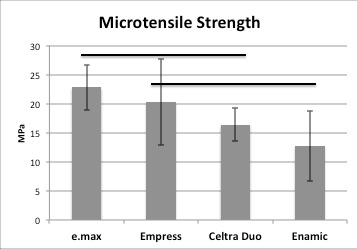IADR Abstract Archives
Comparison of Microtensile Bond Strength Between e.max and Other Ceramics
Objectives: Recently introduced IPS e.max CAD (Ivoclar Vivadent, Amherst, NY) material for dental implant abutments may pose a challenge when being restored with various new ceramic CAD/CAM crown materials. Cementing ceramic materials to ceramic materials presents a novel challenge for adhesion in the oral cavity. This project compared microtensile bond strength of various ceramic crown materials cemented to IPS e.max CAD abutment material.
Methods: Four ceramic materials were selected for analysis: IPS e.max CAD ; Empress CAD (Ivoclar Vivadent); Celtra Duo (Dentsply, York, PA); and Enamic (Vita, Yorba Linda, CA). Blocks of each material were sectioned in half and e.max samples were fired according to manufacturer recommendation. Samples (n=2 each) were wet polished through 600 grit abrasive paper and cleaned with Ivoclean cleaning paste. One surface of each sample was treated with Etch and Prime (Ivoclar Vivodent). A 100 micron spacer was placed between an e.max block and each ceramic sample. Variolink Esthetic DC (Ivoclar Vivodent) was used to cement the blocks together. Initial set occurred with light and then bench cured (8 additional minutes). Samples were stored at 37°C (100% humidity) for 48 hours. Microtensile test bars (2x2x13mm) were cut from the bonded blocks using an Isomet 5000precision saw (Beuhler, Lake Bluff, IL). A custom microtensile jig was used with an Electropuls E-3000 mechanical test system (Instron, Norwood, MA). Maximum load at failure was recorded for each sample. Comparison of microtensile bond strength between samples was accomplished using ANOVA with post-hoc Tukey (a=0.05).
Results: Although IPS e.max CAD, Celtra Duo, and Empress were statistically the same, only e.max-to-e.max provided higher microtensile bond strength when compared to Celtra Duo. See figure below.
Conclusions: Although Enamic is being used clinically in cementation to e.max abutments, it may pose problems because of its lower microtensile bond strength compared the the other ceramics tested.
Methods: Four ceramic materials were selected for analysis: IPS e.max CAD ; Empress CAD (Ivoclar Vivadent); Celtra Duo (Dentsply, York, PA); and Enamic (Vita, Yorba Linda, CA). Blocks of each material were sectioned in half and e.max samples were fired according to manufacturer recommendation. Samples (n=2 each) were wet polished through 600 grit abrasive paper and cleaned with Ivoclean cleaning paste. One surface of each sample was treated with Etch and Prime (Ivoclar Vivodent). A 100 micron spacer was placed between an e.max block and each ceramic sample. Variolink Esthetic DC (Ivoclar Vivodent) was used to cement the blocks together. Initial set occurred with light and then bench cured (8 additional minutes). Samples were stored at 37°C (100% humidity) for 48 hours. Microtensile test bars (2x2x13mm) were cut from the bonded blocks using an Isomet 5000precision saw (Beuhler, Lake Bluff, IL). A custom microtensile jig was used with an Electropuls E-3000 mechanical test system (Instron, Norwood, MA). Maximum load at failure was recorded for each sample. Comparison of microtensile bond strength between samples was accomplished using ANOVA with post-hoc Tukey (a=0.05).
Results: Although IPS e.max CAD, Celtra Duo, and Empress were statistically the same, only e.max-to-e.max provided higher microtensile bond strength when compared to Celtra Duo. See figure below.
Conclusions: Although Enamic is being used clinically in cementation to e.max abutments, it may pose problems because of its lower microtensile bond strength compared the the other ceramics tested.

